
(Recipe from Tracey’s Culinary Adventures here.)
Step by Step Instructions:
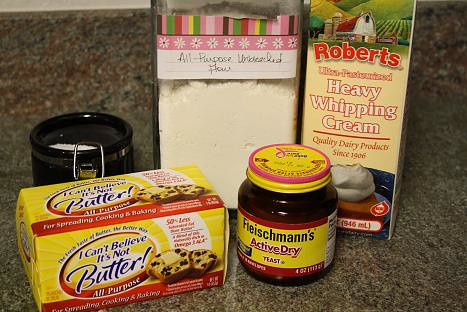
To make the croissants, the following ingredients are needed: Salt, All-Purpose Flour, Heavy Cream, Active Dry Yeast, and Cold Butter (3 1/2 sticks).
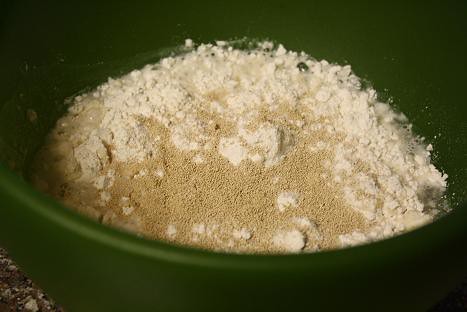
Begin by combining 1 cup of flour, 1 cup of warm water (to activate my yeast, it needed to be between 100 and 115 degrees Fahrenheit), and 1 teaspoon of active dry yeast.
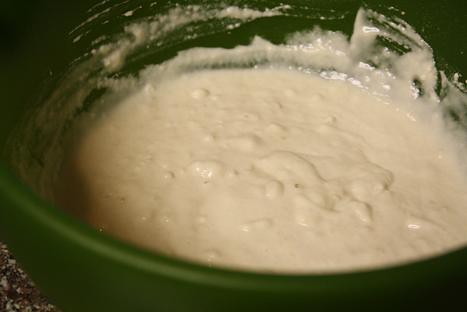
Combine it just until all of the lumps of flour have been mixed in.
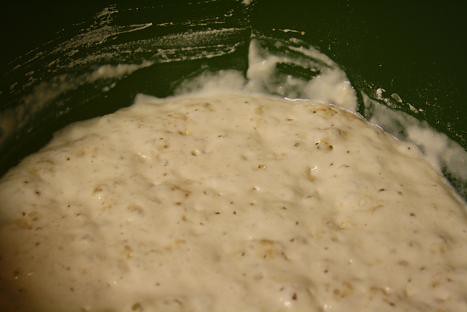
Then cover it and set the bowl aside (I just put it on the counter) for about an hour. You’ll see that bubbles begin to form on the top.
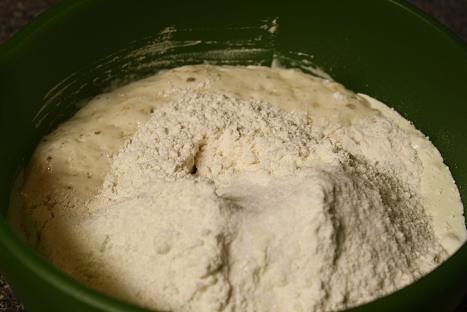
Add the remaining 2 1/2 cups of flour, 1/3 cup of heavy cream and 1 teaspoon of salt to the risen dough and knead it (I stirred it with a wooden spoon) for about a minute.
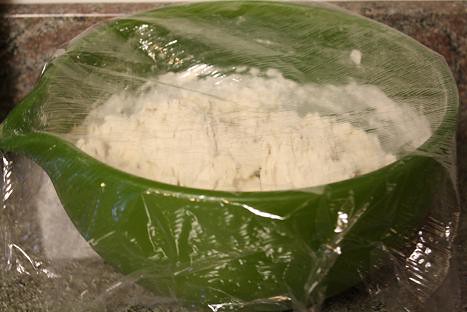
Then cover the bowl with plastic wrap and set it aside for 20 minutes to let it rest.
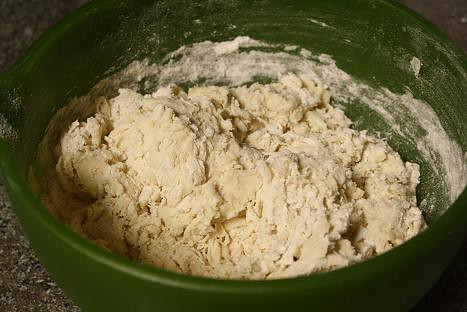
Once rested, it will look like the above. Place the dough in a stand mixer and using the dough hook attachment, mix it for 20 minutes on the lowest speed. Alternatively, you can knead the dough by hand for 10 minutes.
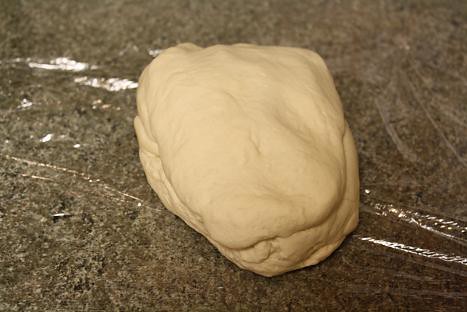
I opted to go the mixer route, which worked really well for me. Once the dough is finished it will be smooth and elastic-y. At this point, cover it with plastic wrap and refrigerate the dough for 30 minutes.
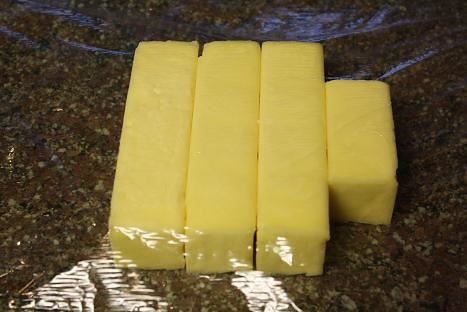
Now it’s time to deal with the block of butter. I took the 3 1/2 sticks of butter and placed them between two sheets of plastic wrap. You can either use a rolling pin to beat the butter together or the heel of your hand, but the idea is to combine the butter so that it’s in an 8″ x 8″ square…
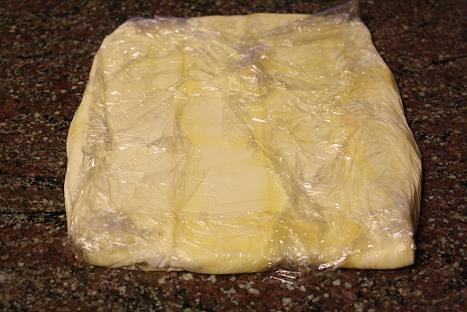
…like this. Then pop it in the refrigerator until you’re ready to use it, so that it stays nice and cold.
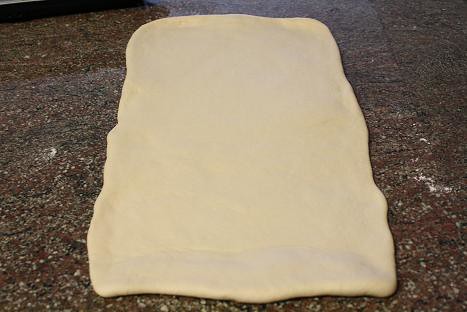
After 30 minutes of cooling, roll out the dough into a 9″ x 17″ rectangle as you can see above. This recipe is a great example of why every kitchen should have a ruler stashed away in it.

Then pull the butter out of the refrigerator, unwrap it, and place the square at the bottom of the rectangle, as you see above.
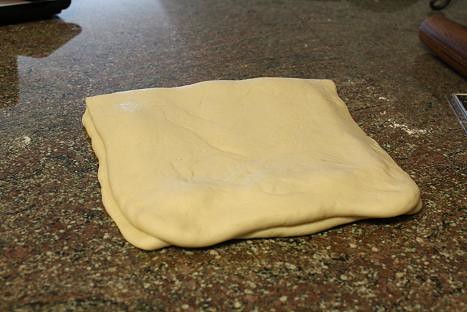
Then grab the dough and fold it over the butter pulling it from top to bottom to cover up the square of butter.
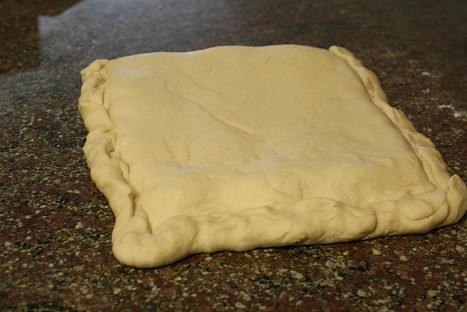
At this point, I carefully sealed the edges of the dough by crimping them and then folding them up and making sure that there weren’t any air pockets. Then lightly pound the dough and butter to incorporate them a bit.
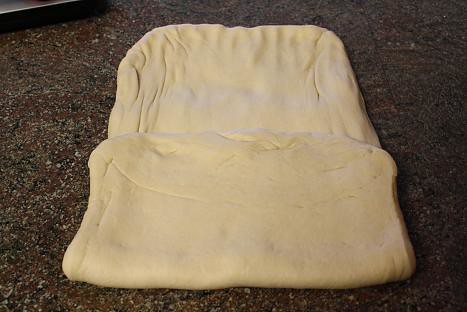
Then the dough gets rolled into a 9″ x 18″ rectangle. Once rolled out, fold up the bottom third of the dough as you see above. Then fold down the top third of the dough…
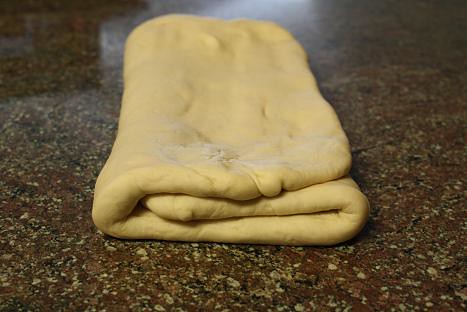
…and rotate it so that the folded edge is on your left (think of it like the spine of a book). This is one “turn”. Now repeat the process by rolling out the dough to a 9″ x 18″ rectangle at this point. Once there, fold it in thirds as shown above. Then turn it so the “spine of the book” if you will is on your left again. Then it’s a good idea to press two fingers into a corner of the dough to remind yourself you have completed your second turn. Cover the dough with plastic wrap and refrigerate it for at least an hour. Once it’s been refrigerated, pull it back out and complete two more turns as shown above. Make sure to start rolling out with the “spine of the book” on your left side, and repeat until you’ve done a total of four turns.
At this point, your dough is ready to be rolled out and formed into the rolls. Alternatively, you can wrap the dough in plastic and refrigerate it for up to 24 hours before you shape and proof. On the website, Tracey notes that the recipe states that 12-24 hours in the fridge before proofing improves the flavor of the dough. So I went ahead and let it sit in the fridge overnight.
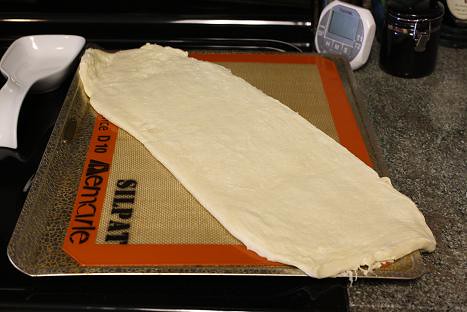
Once proofed, I went ahead and cut the dough in half and rolled out each half into 6 1/2″ x 20″ rectangles. I placed each rectangle on a lined cookie sheet (I used my Silpat to line the cookie sheet), and refrigerated them for about 20 minutes.
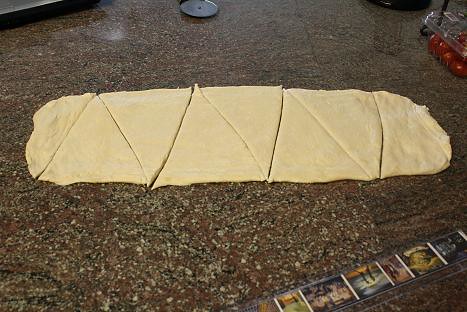
Then working with one rectangle at a time (I left the other in the fridge) and working fairly quickly, so that the dough didn’t get too warm, I did the following: On the side closest to me, I made 4 small notches every 5 inches. Then on the other side, I measured 2 1/2″ then made a notch, then made a notch every 5 inches 3 times, so you should have two 2 1/2″ sections (one on each end) and three 5″ sections on that side. Then using a pizza cutter, I connected the notches as you can see above to create 6 large triangles. The end pieces can be discarded, because they aren’t large enough to work with.
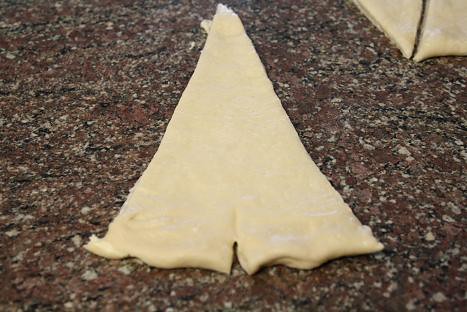
To form the rolls, work with one triangle at a time. Cut a notch in the middle of the long end. Then using both hands, tightly roll the dough towards the point and move your hands in opposite directions to get the roll to curl out.
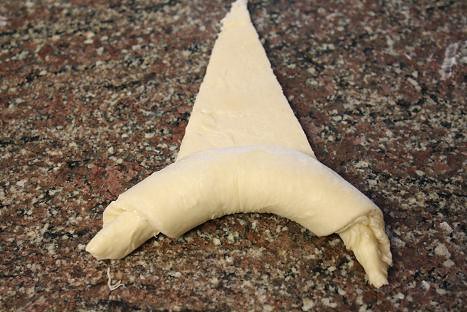
Here is an example of a halfway rolled croissant. You can see that by using two hands and rolling out (at about a 45 degree angle), you get the curved effect of the classic croissant…
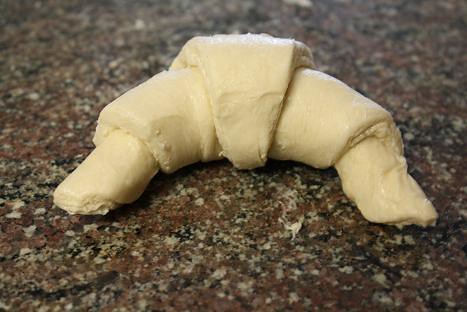
…until it looks like this when finished.

I then placed six rolls per cookie sheet back in the refrigerator and let them cool in there over night. You could also let them sit out for an hour or sit for 3 hours in a cool place and then bake immediately, but the flavor is supposed to intensify overnight. It’s really up to you.
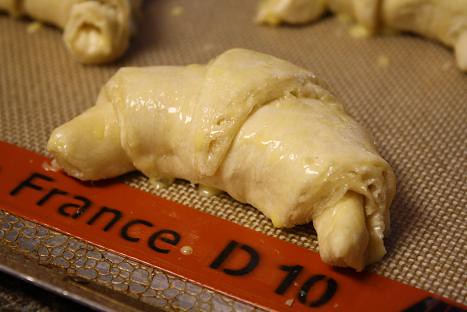
The following morning, I let the croissants get close to room temperature (sitting out for an hour or two) and then I brushed each with an egg wash consisting of one egg beaten with a splash of cream.

I then baked the rolls in a 375 degree oven for 35 minutes until they were golden brown on top. Let them cool completely before enjoying…they are flaky, buttery and extremely decadent. I’m so proud of my achievement and can’t wait to try my hand at this recipe again. I hope these step by step instructions help you see that croissants aren’t as scary as they first appear. Bon Appetit!

Croissant Dough
(from Baking, by James Peterson)
Ingredients:
3 1/2 cups all-purpose flour
1 cup barely warm water
1 teaspoon active dry yeast
1/3 cup heavy cream
1 teaspoon salt
1 3/4 cups cold unsalted butter (3 1/2 sticks)
Tracey’s Preparation Instructions:
1. In a medium bowl, mix 1 cup of the flour with the water and yeast just until the lumps of flour are broken up. Set the bowl aside and let rise for 1 hour. (I couldn’t see a noticeable rise in mine after an hour but there were bubbles all over the surface.)
2. Add the remaining flour, the cream and salt and knead the mixture for 1 minute. Cover the bowl with plastic wrap and let rest for 20 minutes.
3. Knead the mixture by hand for 10 minutes or in a stand mixer fitted with the dough hook (on low speed) for about 20 minutes. The dough should be smooth and elastic by the time you finish kneading. (I kneaded mine with the mixer and it was a breeze. I did give the mixer a brief 2 minute rest after 10 minutes out of an abundance of caution to make sure it didn’t overheat, but the motor never got very warm so it probably wasn’t necessary. The dough is silky and smooth and just gorgeous after it’s been kneaded.) Wrap the dough in plastic wrap and refrigerate for 30 minutes.
4. Place the butter between two sheets of plastic wrap and using a rolling pin, pound the butter into an 8-inch square.
5. Remove the dough from the refrigerator and on a lightly floured surface, roll it into a 9 x 17-inch rectangle. Place the square of butter on the bottom half of the rectangle. You can use your hands to align the dough and the sides of the butter square.
6. Fold the top half of the rectangle of dough down over the bottom half so the square of butter is now enclosed. Press together the edges of the square to seal in the butter. Use your hands to even out the square. (You can see my butter peeking out here if you look closely on the side – I hadn’t yet sealed it in.)
7. Gently pound the square with a rolling pin to stretch the dough and the butter in it. Roll the dough into a 9 x 18-inch rectangle. Next, you want to fold the rectangle into thirds like a letter – start with a narrow end facing you. I began by folding the bottom third up.
8. Then folded the top third down… You’ve now completed one “turn!”
9. Turn the dough so the single fold (like the spine of a book) is on your left.
10. You’re now ready to start the second turn. Repeat the process shown above of rolling the dough into a 9 x 18-inch rectangle, then folding the rectangle into thirds by bringing the bottom up and the top down over it. Use your fingers to make two imprints on the dough to keep track of the fact that you’ve completed two turns.
11. Wrap the dough in plastic wrap and refrigerate for at least 1 hour. Once the dough has been refrigerated, remove it and complete two more “turns” – for a total of four turns in all. At this point, the dough is ready to be rolled out and used. Alternatively, you can wrap in plastic and refrigerate it for up to 24 hours before you shape and proof (in fact, the recipe notes that 12-24 hours in the fridge before proofing improves the flavor of the dough).
12. Before you begin to shape the dough, line two large baking sheets with parchment. Also, make sure you have a ruler handy. Cut the dough in half. (I took a photo of the dough at this point because I was amazed by all of the layers you could see!)
13. On a lightly floured surface, roll each half of the dough into a 6 1/2 x 20-inch rectangle. (You can trim the edges of the dough if they’re ragged or really uneven.) The dough will be about 1/8 – 1/4-inch thick.
14. Transfer each large rectangle onto one of the prepared baking sheets and refrigerate for about 20 minutes. You want the dough firm, but not brittle.
15. When the first rectangle is ready to work with, transfer it back to your work surface with one of the long ends facing you. The next step is to cut the triangles from the dough that will be formed into individual croissants. Starting on the left side of the bottom edge of the rectangle, measure 5 inches from the end and make a tiny notch to mark the base of the first triangle. Measure another 5 inches from that notch and make a second notch to mark the base of the second triangle. Finally, repeat one more time – measure another 5 inches and make a notch. You should now have marked off four 5-inch sections.
16. Turn the rectangle 180 degrees so the opposite long side (the one that hasn’t been notched) is facing you. Starting on the left side, make a notch 2 1/2 inches from the end. Measure 5 inches from the first notch and make a second notch. Measure another 5 inches from the second notch, make a third notch and finally, measure 5 inches from the third notch and make your final notch. This second side of the triangle should now be marked into 5 sections – the 2 sections at the ends will each be 2 1/2 long and the
ones in the middle 5 inches long.
17. You’re ready to cut the triangles which will form the croissants now. Leave the rectangle as is – so the second side you notched is closest to you. The notches on the far side are for the bases of the triangles and the notches on the near side form the tips of the triangles. Use a large knife to cut the triangles by connecting the notches on the near and far sides. You should end up with 6 full triangles, each 5 by 6 1/2-inches, as well as some trimmings on the ends. I took this photo just after I’d cut the triangles.
18. Repeat the process above with your second rectangle so you have a total of 12 triangles. Make a small slit in the base of the center of each triangle.
19. Begin to roll the triangles to form the croissants by curling the two sides of the triangle on each side of the slit away from each other. You want to roll tightly.
20. Using both hands, continue to roll the base of the triangle – one hand working with the dough on each side of the slit. Point your hands away from each other – at about 45 degree angles from center – as you roll. Rolling in this manner will help make the classic croissant shape.
21. Roll each triangle so the tip is underneath and then bend the 2 ends toward each other to form a shape like a little crab. Hopefully you can see 3 distinct layers as the dough curls to form the croissant. Arrange the croissants on a sheet pan and cover them with plastic wrap to proof.
22. You have several options for proofing: overnight in the fridge, ~3 hours in a cool place or ~1 hour in a warm place. The book indicates that overnight proofing is best because the croissants develop more flavor thanks to the slow rising time. (I proofed mine overnight in the fridge and then took them out in the morning and let them sit at room temperature for a few hours before baking.)
23. Preheat the oven to 375 F. Adjust your oven racks so one is in the top third and one is in the bottom third of the oven. Combine 1 egg with a splash of cream to form an egg wash and brush the proofed croissants. Bake for about 35 minutes, or until the croissants are puffed and golden brown. Remove them to a wire rack to cool to room temperature before serving.
0



Leave a Reply